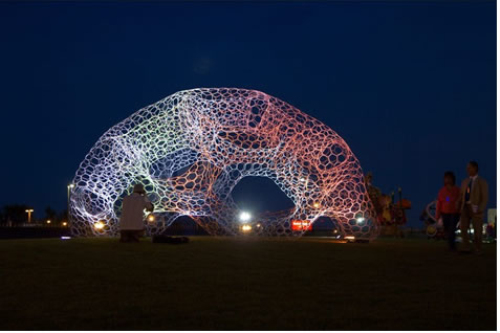Hamburg, Germany, is now building the world’s first algae-powered building. The house’s hot water, lighting, warmth, and power facilities will all be entrusted to renewable energy microalgae. Regarding the imagination of future buildings, the architect team of this building believes that the future urban architecture will be “born†with biological characteristics, just like living creatures, able to respond to the local environment and interact with residents. The London-based design studio Loop pH believes that this is not enough. In addition to knowing how to integrate architectural design and science, the architects of the future must understand the art. Taking inspiration from the chemical bonds that connect atoms in biological molecules, Loop pH Studio designed a lighting art museum named “SOL Domeâ€. This is a lighting art museum fully woven of composite fibers, powered by solar energy, and will change the brightness and color according to the concentration of carbon dioxide. Its first major highlight is lightness, and the house consists of thousands of interconnected, ultra-lightweight buildings. The composite fiber, which is 8 meters long and 4 meters wide, weighs only 40kg, is the lightest house in the world. To assemble a house, we first need to weave these composite fibers into circular rings, and then connect these rings to each other to assemble a honeycomb structure house. In Fall, USA, October, “Fall In Art and Sol†At the solar energy festival, it took three days for members of the Loop pH design studio and volunteers to build the house. SOL Dome is the world's first person to meet with the world as a solar art house. "Taking it natural and sensing nature" is the artistic meaning of this lighting museum. These composite fibers contain LED lamp elements and carbon dioxide sensors. In addition to lighting conditions based on solar energy, the carbon dioxide sensors in the fiber will respond to the amount of carbon dioxide released from the air at a certain point in time, allowing the house to transform into different colors and Different rhythm lights. The concentration of sunlight and carbon dioxide changes every moment, and lighting museums of different colors are transformed accordingly, just like a living building that breathes and has vital signs. In the evening, the higher the concentration of carbon dioxide, the color of the optical fiber ring will become deeper and deeper. In the quiet night, the colorful houses seem to make the night have a breath. “We believe that the SOL Dome is the foundation of future architecture and that the house of the future will be able to adapt to the surrounding environment like an organism. Now we are trying to create in the city art that can bring forward the most advanced research in biology and public domain energy. And bring these works of art to the park in the city center so that ordinary people can also participate in this study to understand what will happen in the future and bring people closer to science and nature,†said the Loop pH team. Many people believe that the existence of the SOL Dome can well reflect the situation of the surrounding environment. This has taken a big step forward in the bionic architecture that imitates the structure of biological structures. The core idea of ​​the Loop pH team is to integrate architecture, design, and science by interpreting the relationship between human living environment and science, and realize the convergence of scientific mechanisms and art design of renewable energy. Garne Ulm, who is responsible for the development of algae-powered buildings, also believes that the potential for “living buildings†in the future is limitless. By 2050, the global population will reach 9 billion, and 75% of the population will live in cities. The continued population growth will exert tremendous pressure on the already strained natural resources and the city’s construction environment will change dramatically. Ulm explained that the green space will be distributed throughout the entire building, and the water resources system will have the functions of recycling, reuse and filtration to reduce the pollutants that affect the environment. Urban residents and cities will also be in a state of flux. Buildings in the future will tend to be integrated with the structure of the city. They will be able to respond to changes in the external environment. The building's networked intelligent devices will keep busy and busy cities. Can be controlled in real time. Since 2003, Loop pH Studio has embarked on projects that combine science and design, including an ordinary community renovation program and the upgrading of the Kensington Palace in London. They hope to create a suitable living environment for people. “We hope this can be a house that can shelter people from rain and rain, and it can also be a house that allows people to think about nature and the universe.†Because humans are not willing to walk on the ground, they must fly like birds in the sky. Similarly, humans are not willing to be manipulated by nature, and they also know how to return to nature and seek development. In the future, the architects will obviously not only be content with bionic structures that are very animal and wild, and humans will focus on the laws of the natural world and will find more perfect answers in those “living buildingsâ€.
Jinan Realglow Photoluminescent Aluminum Sheet are made of Realglow Photoluminescent Pigment and good quality Aluminum Sheet. After absorbing visible light for 10-30 minutes, photoluminescent sheets will glow more than 20 hours in the darkness. They are best luminescent sheet(board) for producing all kinds of safety sign and Exit Sign.
Photoluminescent Aluminum Sheet Aluminum Sheet,Glow In The Dark Aluminum,Luminescent Aluminum Board,Luminous Aluminum Sheet JINAN REALGLOW CO.,LTD , http://www.realglowsign.com


Each LED fiber optic ring is like a fully charged battery at night. 
Carbon dioxide sensor controls the house's breathing rhythm 
Bionics are not as good as living buildings in the future